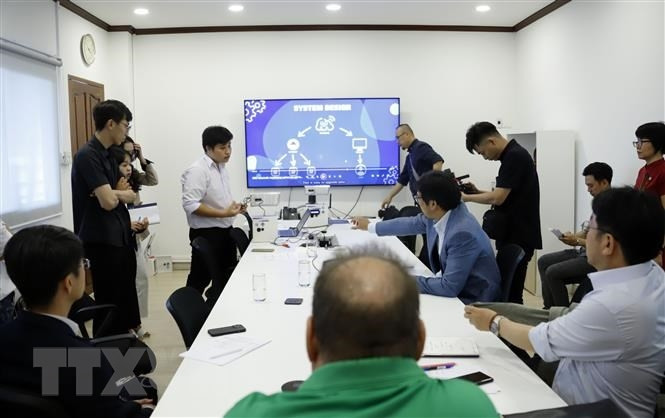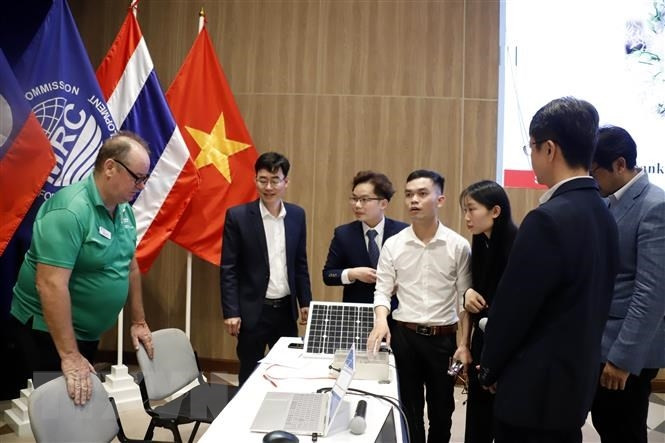The specific task of the competition is to develop remote sensing technology to measure four separate indicators including water level, rainfall, soil moisture and water quality.

Students from Can Tho University in Vietnam present their invention idea to the jury. (Photo: Pham Kien)
On the afternoon of March 30, in the capital Vientiane, Laos, a competition to find modern technology for river monitoring took place.
This is a competition for regional university students launched by the Mekong River Commission (MRC) to develop sustainable and cost-effective technologies to monitor water levels, rainfall, soil moisture and water quality in the Mekong River.
In Vientiane, the competition was attended by 14 teams from 11 universities in 4 MRC member countries including Cambodia, Laos, Thailand and Vietnam, of which Vietnam has 4 schools including Thuyloi University, Can Tho University, Ho Chi Minh City University of Science and Hanoi University of Science under Vietnam National University.
The MRC maintains about 250 monitoring stations that monitor factors affecting Southeast Asia's largest river including hydrology, rainfall, water quality, ecological health, fisheries and drought.
However, most current monitoring technology relies on equipment imported from abroad - often expensive and sometimes outdated.
Sharing with reporters, Mr. Santi Baram, in charge of Strategy and Partnerships of the MRC Secretariat, said that the competition is aimed at encouraging young students from universities in the four member countries to compete in developing innovative technologies with the expectation of being able to take advantage of some “homegrown” technologies researched by the universities, thereby reducing the cost of monitoring the Mekong River.
Speaking at the launch of the competition in October 2022, Dr. Anoulak Kittikhoun, CEO of the MRC Secretariat, stressed that homegrown solutions are not only cheaper, but also help develop local expertise and bring other benefits such as fostering the belief that Mekong people can solve Mekong problems themselves through technological innovation.
The specific task of the competition is to develop remote sensing technology to measure four separate indicators including water level, rainfall, soil moisture and water quality.
These sensors are typically installed in dedicated stations, or outdoors on river banks, often in agricultural areas.

Students from Vietnam University of Water Resources present their invention idea to the jury. (Photo: Pham Kien)
Contestants will design a station that is suitable for the terrain, location, weather, and function of the station; the station can operate on solar power; and has the ability to collect and send telemetry data from the station to a server in real time.
Coming from Can Tho University, where the Mekong River flows through, Nguyen Le Hong Nhung, a fourth-year student majoring in high-tech agriculture, said her group's idea was to develop a soil moisture measurement system to help farmers in the Mekong Delta, as well as farmers in the lower Mekong region, grasp the moisture of the soil and thereby be able to better manage their land.
According to Nhung, today's youth are completely capable of designing systems that are cheaper and of better quality than products on the market.
Bringing to the competition a device that can monitor water quality, water levels, and rainfall, student Virbora NY, from the Polytechnic Institute of Cambodia, said that the Mekong River is facing many problems, so the young generation of the countries downstream of the Mekong River needs to participate in solving the problems of the river because the Mekong River flows through many countries and is a source of natural resources, water resources, fish resources, and nutrient-rich alluvium, bringing sustainable life along both banks of the river.
Appreciating the ideas brought to the competition, Mr. Santi Baram said that the students came up with many ideas that showed understanding and were very creative, especially living along the river helped the students better understand the technologies that need to be applied in the lower Mekong River.
According to the program, the presentations of 14 teams will take place on March 30-31, from which 4 winning teams will be selected based on criteria including accuracy, durability, cost-effectiveness and innovation.
The award ceremony will then take place on the afternoon of April 3. The products of all 14 schools will then be displayed at the Lao National Convention Center for the leaders of MRC countries and guests attending the MRC Summit to visit.
The MRC also plans to work with the winning teams to deploy their technologies on the Mekong.
According to VNA